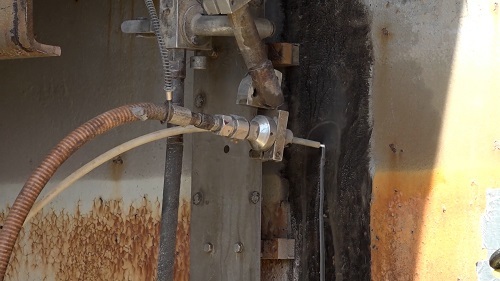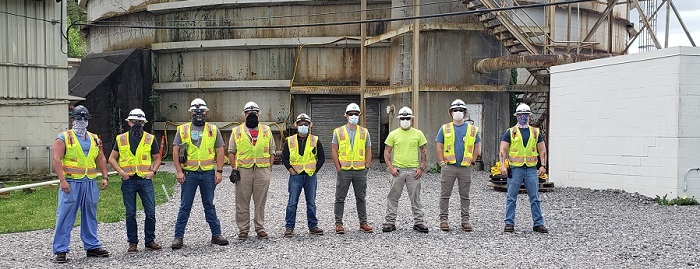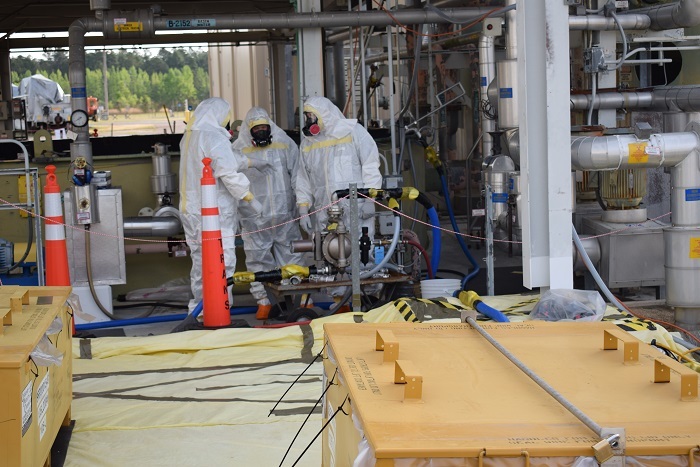 Crews prepare the Experimental Gas-Cooled Reactor for deactivation. The eight-story facility at the Oak Ridge National Laboratory stands 216 feet tall.
OAK RIDGE, Tenn. – EM crews are preparing to deactivate the former Experimental Gas-Cooled Reactor (EGCR) at the Oak Ridge National Laboratory (ORNL) before removing the contaminated facility and opening the DOE land for reuse.
The EGCR is one of 16 inactive research reactor and isotope facilities EM is addressing at ORNL. This massive cleanup effort is happening simultaneously with other cleanup projects underway at the Y-12 National Security Complex.
EM’s cleanup at these sites is eliminating risks, enabling modernization, protecting current research and science missions, and opening land for new research and national security facilities.
At the EGCR, Oak Ridge Office of Environmental Management and cleanup contractor UCOR are working to make the facility safer for deactivation and demolition crews by removing combustibles, abating loose asbestos-containing materials, and creating multiple emergency exits.
The UCOR team used an innovative technology to create an additional exit from the building. Workers used a waterjet process with a garnet-based abrasive — similar to an intense pressure washer but using a sharp, angular mineral agent — that was able to cut an opening in the facility’s thick carbon-steel outer shell. This method avoided hazards associated with torch cutting, and it was less labor intensive than using standard hand tools.
 |
|
UCOR used an innovative technology to cut an opening through the thick carbon-steel outer shell of the Experimental Gas-Cooled Reactor. The system uses a waterjet process with a garnet-based abrasive. This method avoided hazards associated with torch cutting, and it was less labor intensive than using standard hand tools. |
 This UCOR electrical team isolated all potentially hazardous energy sources at the Experimental Gas-Cooled Reactor to move the facility to a “cold and dark” state. This process is a crucial step prior to deactivation, which is slated to begin this summer.
EM and UCOR are also collaborating to perform the work in a cost-efficient manner. They identified an opportunity to reuse unique equipment across multiple projects, saving nearly $3.5 million. UCOR moved transport platforms — large elevator-like devices installed outside facilities — to this project from the Biology Complex.
While the Biology Complex stood six stories tall, the EGCR stands eight stories and requires these special platforms for the deactivation phase to access upper levels and move crews, equipment, and supplies more easily.
EM and UCOR have moved the facility to a “cold and dark” state. This process is a crucial step prior to deactivation that requires isolation of all potentially hazardous energy sources. The EGCR deactivation phase is slated to begin this summer.
In 1956, Congress directed the Atomic Energy Commission (AEC), which would later become DOE, to build the EGCR, a gas-cooled, graphite-moderated reactor — the first civilian reactor of its kind in the U.S.
The 107,922-square-foot facility, standing 216 feet tall, was intended to be more than an experimental reactor. It was to be a prototype for the Tennessee Valley Authority’s nuclear power generation. TVA is a corporate agency of the U.S. that provides electricity for business customers and local power companies, serving 10 million people in parts of seven southeastern states.
However, in 1965, when the facility was 90-percent complete, the AEC decided to go in another direction and stopped construction of the EGCR.
The reactor was never put into service, but its control, service, and turbine buildings were later used as development space for other research programs. The facility would go on to house ORNL’s fuel recycle division.
-Contributor: Carol Hendrycks
RICHLAND, Wash. – DOE recently bestowed the prestigious 2021 Classification Award of Excellence to an employee of EM Richland Operations Office contractor Hanford Mission Integration Solutions (HMIS) for his outstanding contributions to the Department’s classification program.
Hanford classification officer and HMIS information security manager LaMont Schofield led two high-impact projects that will result in a large reduction of classified documents, improved processes and quality control, and cost savings for the Hanford Site.
“Mr. Schofield earned this award through his significant contributions to the Department of Energy classification program at the local and national levels,” Matthew B. Moury, DOE Associate Under Secretary for Environment, Health, Safety and Security, said in a letter to HMIS. “His professionalism has enabled him to maintain the respect of his peers within the classification community.”
 |
|
DOE recognized Hanford Mission Integration Solutions classification officer LaMont Schofield for his leadership and contributions to projects that reduced the number of hard-copy classified documents and storage necessary on the Hanford Site. Schofield received DOE’s prestigious 2021 Classification Award of Excellence. |
The first project Schofield led reduced the number of active hard-copy classified documents by more than half, converting most material to digital format. Having fewer hard-copy documents in existence lowers the risk of potential security concerns related to handling sensitive material, while increasing the efficiency and ability to control distribution.
In selecting Schofield for this award, DOE noted his oversight role in the Hanford projects and the “tremendous savings of both time and money” that resulted from his efforts.
“This recognizes LaMont’s leadership in combining deep understanding of our classification program goals with an innovative approach to make a significant difference,” said David Chase, vice president of HMIS safeguards, security, and emergency services.
-Contributor: Robin Wojtanik
 Workers prepare to remove sediment from the L Basin settler tank at the Savannah River Site.
AIKEN, S.C. – An EM team at the Savannah River Site (SRS) has finished safely removing sediment from a key component of a basin used to store spent nuclear fuel from former production reactors, and from foreign and domestic research reactor programs.
The underwater storage facility, known as the L Disassembly Basin, holds approximately 3.4 million gallons of water, with pool depths of 17 to 50 feet. The basin water provides shielding to protect workers from radiation. The settler tank is part of a sand filter filtration system used to remove sediment from the basin to ensure water clarity.
“It’s important that the water in L Basin remains clear, so operators can see what they are doing when they handle fuel under water,” said Neil McIntosh, L Basin deputy facility manager for Savannah River Nuclear Solutions (SRNS), the SRS management and operations contractor. “Over time, the settler tank becomes full, and we have to remove and safely dispose the contaminated sediment.”
The last time sediment needed to be pumped from the tank nearly 20 years ago, L Basin personnel used equipment known as a sludge processing unit, which would require expensive modernization work to use again.
Waste management personnel worked with the Savannah River National Laboratory to obtain commercially available products to safely perform the sediment removal, a less expensive alternative.
“After a pump removed the water and sediment from the tank, a cloth-like membrane retained the sediment,” McIntosh said of the new, innovative system. “This material was then placed into a waste container that will be shipped to the SRS Solid Waste Management Facility and the water was returned to L Basin.”
The project created a mock-up of the new removal process, including replicated sediment material, to ensure the safety and proper training of employees, and the viability of the removal equipment. Individuals tasked with performing hands-on work participated in several test runs to help develop procedures and ensure they are implemented correctly. Team members applied several lessons learned from those activities in final planning for the sediment removal.
“The work to remove the sediment from the settler tank will ensure the life of L Basin will be extended for as long as it is needed,” DOE Program Manager Michele O’Shaughnessy said. “The collaboration, teamwork and careful planning by SRNS helped ensure successful sediment removal in a safe and cost-effective manner.”
-Contributor: Lindsey MonBarren
|